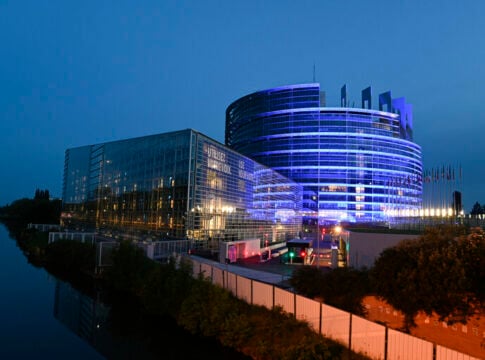Op-ed by Mariya Gabriel
European Commissioner in charge of the Digital Economy and Society
Companies able to take full advantage of digital infrastructures, process and disseminate digital products and services will be the ones who will benefit the most of today’s data economy and society. However, among today’s digital industry giants (Google, Apple, Facebook, Amazon, Microsoft), none of them is European.
This is one of the reasons why the Digital Single Market is one of the top priorities of the European Commission. It is also why the European Union needs to build, as soon as possible, state of the art digital infrastructures including a world-class European supercomputers infrastructure, built around super powerful and efficient machines able to process large amounts of data, and perform calculations thousands of times faster than a normal computer.I am hopeful that the EU can make real progress under the Bulgarian Presidency which has put digital high on its agenda for the next six months.
Already today supercomputers allow our society to take advantage of innovations in health care, engineering, renewable energy, car safety and cybersecurity and other technologies.
The applications are countless and I am pleased that the European citizens can already benefit from them. High-Performance Computing allows us, for instance, to design and simulate the effects of new drugs, provide faster diagnosis and better treatments and predict future epidemics.
Dr. Zoe Cournia from the Biomedical Research Foundation of the Academy of Athens (BRFAA) , Greece, extensively uses High Performance Computing (HPC) services from providers in Greece and the EU to investigate how mutations in proteins can lead to cancer. Analysing data from simulations, scientists can design candidate drugs explicitly for mutated proteins. These drugs should not affect normal proteins thus reducing side effects. This work is based on the concept of ‘precision medicine’ that targets very specific cancer types to treat patients more effectively. By taking advantage of computational simulations executed on Europe’s most advanced HPC nodes, the time and cost of designing new candidate drugs has been significantly reduced. Usually, the time required to develop a new drug ranges between 10 and 17 years – if it ever makes it. There are also rising costs that make this increasingly unaffordable for both companies and patients. The testing of drug candidate molecules can be greatly accelerated by using High Performance Computing (HPC).
Supercomputers are equally used for ever higher resolution simulation in climate change, for example, studying the behaviour of the oceans, weather forecasting and earth resource evolution. Simulations like these are useful for early warning of storms and for long-term climate scenarios and adaptation strategies concerning climate change.
They are also a resource for improving our knowledge of geophysical processes and the structure of the interior of the Earth. In Italy, for example, an international team of researchers has developed a model of the lithosphere below the entirety of Italy based on highly accurate seismic wave imaging, providing a greater understanding of earthquakes in the region. I am persuaded that this technology can help us saving hundreds of lives.
Car makers are now focussing on the future smart mobility: driverless cars. With the huge amount of data these cars will exchange, evaluated at more than four terabytes (approximatively the amount of data you can put on 1000 DVDs) in about an hour and a half of driving, this sector will become a huge supercomputers user.
These are only few examples showing the increasing potential of supercomputers. And as a response to the exponential growth in data, High-Performance Computing is already moving towards its next frontier – from petascale to exascale -, at least 10 times faster than the fastest machines currently in operation and more than 100 times faster than the fastest machines available in the EU.
However not all EU countries have the capacity to build and maintain such infrastructure, or to develop exascale technologies. Moreover, overall, Europe is even losing its place in the top rankings for High-Performance Computing infrastructure capabilities, having been overtaken by China, the US and Japan.
Without world-class supercomputing facilities, Europe will not achieve its ambition of becoming a vibrant data economy. Europe cannot take the risk that data produced by EU research and industry will be processed elsewhere because of the lack of supercomputingcapabilities. This would increase our dependency on facilities in third countries and would encourage innovation to leave Europe.
This is where the European Union’s added value stands and why the European Commission and the Member States came together on 23 March 2017 in Rome with the ‘EuroHPC declaration’. On that day, seven Member States – France, Germany, Italy, Luxembourg, the Netherlands, Portugal and Spain – signed a declaration in support of the next generation of computing and data infrastructure. Since then, 6 more countries endorsed the declaration (Belgium, Slovenia, Bulgaria, Switzerland, Greece and Croatia)
Thanks to these 13 pioneers, we can now go a step further by pooling more investments to establish leading European supercomputers infrastructure. As proposed by the European Commission, the new legal and funding structure – the EuroHPC Joint Undertaking – shall acquire, build and deploy across Europe world-classsupercomputers. At this stage, the EU’s contribution will be around EUR 486 million under the current EU multi-annual budget, matched by a similar amount from Member States and associated countries. Overall, around EUR 1 billion of public funding would be invested by 2020, and private members of the initiative would also add in kind contributions. Beyond the 13 countries, the EuroHPC Joint Undertaking can be joined by any other Members States and associated countries at any moment provided their financial participation. This new legal instrument aims to support the development of systems with exascale performance (a billion billion or 1018calculations per second), based on EU technology, by 2022-2023.
European supercomputing infrastructures represent a strategic resource for the future of EU industry, as it becomes more digital. It is also a great potential source for new jobs. Many small and medium-sized companies need modelling and simulation for their business. For many of them – if not all – the cost of owning and maintaining such technologies is prohibitively high.
This is the EU’s role to support their creativity, innovation and competitiveness.














